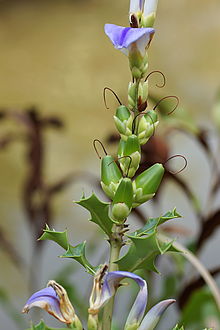Acanthus ilicifolius
| Acanthus ilicifolius | |
|---|---|

| |
| Scientific classification | |
| Kingdom: | Plantae |
| Clade: | Tracheophytes |
| Clade: | Angiosperms |
| Clade: | Eudicots |
| Clade: | Asterids |
| Order: | Lamiales |
| Family: | Acanthaceae |
| Genus: | Acanthus |
| Species: | A. ilicifolius
|
| Binomial name | |
| Acanthus ilicifolius | |
| Synonyms | |
| |
Acanthus ilicifolius, commonly known as holly-leaved acanthus, sea holly, and holy mangrove is a species of shrubs or herbs, of the plant family Acanthaceae, native to Australia, Australasia, and Southeast Asia. It is used as medicine in asthma and rheumatism.[2][3]
Description

The plant grows as a shrub, up to 2 metres (6 ft 7 in) tall. It has shallow tap roots and occasionally develops a stilt root. Fruits are kidney-shaped.[citation needed]
Distribution and habitat
The species is widespread Southeast Asia, Indochina, Indonesia, the Philippines and northern Australia. It occurs in mangrove habitats.[1]
References
- ^ a b Juffe Bignoli, D. (2011). "Acanthus ilicifolius". IUCN Red List of Threatened Species. 2011: e.T168780A6536949. doi:10.2305/IUCN.UK.2011-1.RLTS.T168780A6536949.en.
- ^ Pharmacographica indica page 58
- ^ Singh, Amritpal; Dugval, Sanjiv; Suttee, Ashish (2009). "Acanthus ilicifolius Linn. - Lesser Known Medicinal Plants with Significant Pharmacological Activities". International Journal of Phytomedicine. pp. 431–36.
Further reading
- Barker, R. M. (1986). "A taxonomic revision of Australian Acanthaceae" (PDF). Journal of the Adelaide Botanic Gardens. 9: (1–) 64–75 (–286).
External links
![]() Media related to Acanthus ilicifolius at Wikimedia Commons
Media related to Acanthus ilicifolius at Wikimedia Commons

